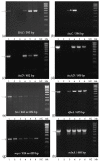In Vitro Evaluation of Some Endophytic Bacillus to Potentially Inhibit Grape and Grapevine Fungal Pathogens
- PMID: 37447114
- PMCID: PMC10347234
- DOI: 10.3390/plants12132553
In Vitro Evaluation of Some Endophytic Bacillus to Potentially Inhibit Grape and Grapevine Fungal Pathogens
Abstract
Romania has a long history of grapevine culturing and winemaking. However, like any agricultural sector, viticulture faces devastating biological threats. Fungi responsible for grapevine trunk diseases (GTDs) and grape spoilage lead to considerable yield losses and a decline in grapevine quality. In the actual context, many countries, including Romania, have reoriented their approaches to minimize chemical inputs, which have been proven to be toxic and to have negative impacts on the environment, and to replace them with sustainable biocontrol strategies for the wine-growing sector. Within biocontrol strategies, Bacillus spp. is a well-known plant-protective bacteria with antifungal properties. Within this paper, six endophytic bacteria from various plant sources were studied. The bacterial strains were identified as B. pumilus, B. subtilis, and B. velezensis by sequencing their 16S rDNA region. Regardless of the in vitro test methods (using living bacterial cells, bacterial-cell-free supernatant (CFS), and volatile active compounds (VOCs)), B. velezensis strains revealed strong and broad antifungal activity against grape and grapevine fungal pathogens such as Aspergillus spp., Botrytis cinerea, Penicillium expansum, Diplodia seriata, Eutypa lata, Fusarium spp., Clonostachys rosea, Neofusicoccum parvum, and Stereum hirsutum. The functional antifungal genes encoding for difficidin, fengycin, iturins, macrolactin, and mycosubtilin were molecularly detected, which could support the proven antifungal activity of the endophytic strains. Lytic enzymes involved in fungal growth inhibition, such as chitinase, cellulase, and proteases, were also revealed to be produced by some of these bacterial strains. Various other in vitro tests, such as phosphate and phytate solubilization, phytohormone synthesis, the production of enzymes involved in the polyamine biosynthetic pathway, and pH as well as temperature tolerance tests were carried out to reveal the plant-beneficial potential of these bacterial strains. These results revealed that the B. velezensis strains, especially BAHs1, are the most suitable endophytes for grapevine biologic control, which could lead to the future development of sustainable management strategies.
Keywords: Bacillus spp.; biocontrol; endophytes; grapevine; molds; trunk diseases.
Conflict of interest statement
The authors declare no conflict of interest.
Figures




References
-
- FAOSTAT. [(accessed on 2 May 2023)]. Available online: http://www.fao.org/faostat/en/#data/QCL.
-
- Pugliese M., Gullino M., Garibaldi A. Effect of climate change on infection of grapevine by downy and powdery mildew under controlled environment. Commun. Agric. Appl. Biol. Sci. 2011;76:579–582. - PubMed
-
- Irimia L.M., Patriche C.V., Roșca B. Climate Change Impact on Climate Suitability for Wine Production in Romania. Theor. Appl. Climatol. 2018;133:1–14. doi: 10.1007/s00704-017-2156-z. - DOI
-
- Chedea V., Drăgulinescu A.-M., Tomoiagă L., Bălăceanu C., Iliescu M. Climate Change and Internet of Things Technologies—Sustainable Premises of Extending the Culture of the Amurg Cultivar in Transylvania—A Use Case for Târnave Vineyard. Sustainability. 2021;13:8170. doi: 10.3390/su13158170. - DOI
Grants and funding
LinkOut - more resources
Full Text Sources
Miscellaneous

